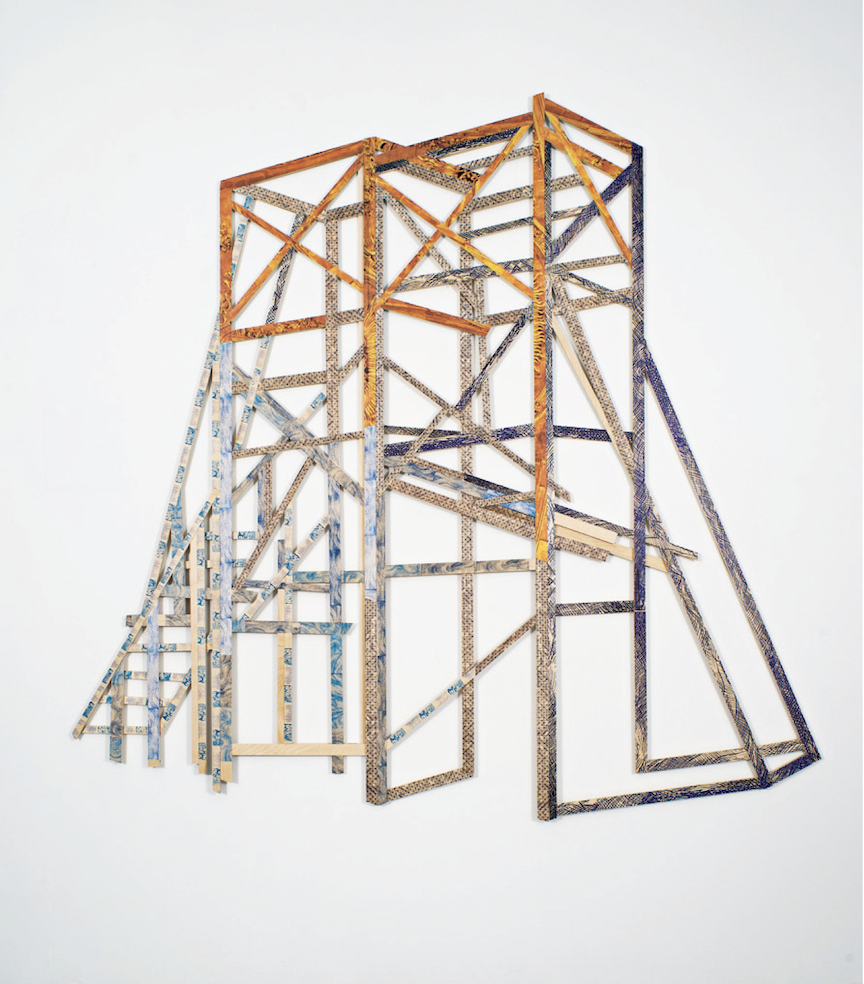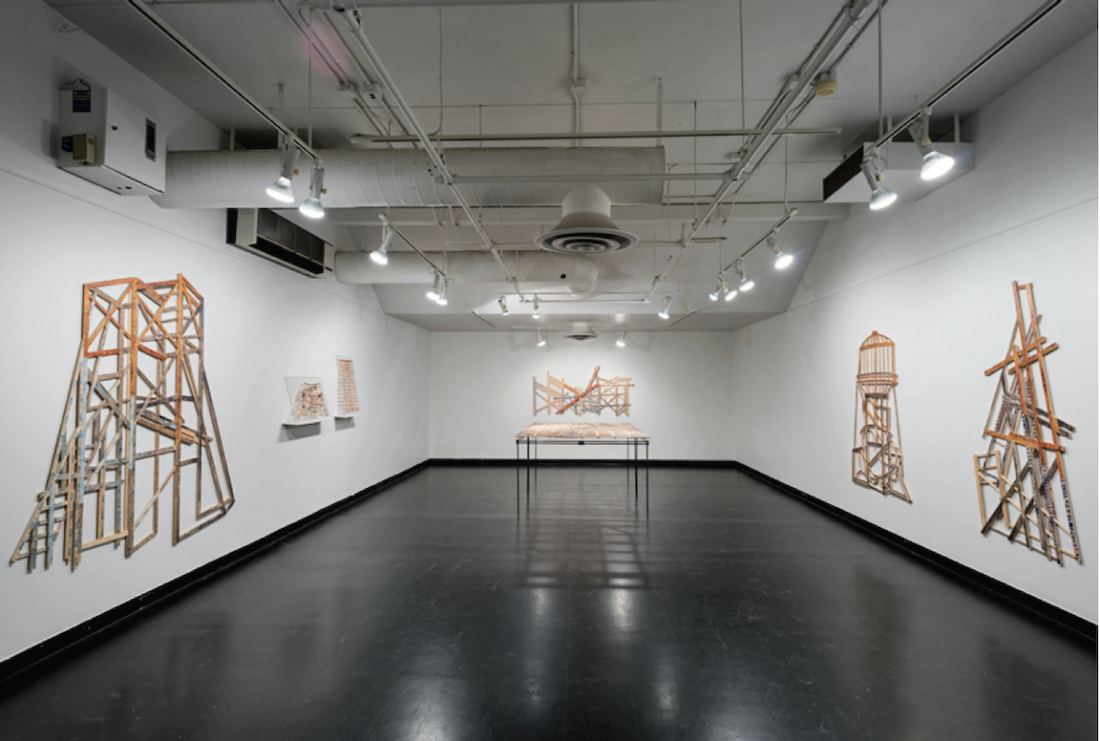Patrick Mahon
It isn’t normally a compliment to say that something doesn’t hold water. We like our vessels without cracks and our roofs without leaks. But in art, at least, a little seepage can be a good thing. Artists are adept at running their hands along the surfaces of contemporary life, searching for the tiniest fissures. With a bit of prying and prodding, these cracks can let through a steady trickle (or, every once in a while, a massive torrent) of new ideas, new images.
Patrick Mahon’s “Water Memory Table” is full of permeable structures. Ideas about human patterns, architecture, historical thinking and water itself flow through the exhibition, and the gaps in Mahon’s constructions provide space for these ideas to mingle and merge. Water & Tower Allegory is a series of wall-mounted wood structures, five of which were included in the exhibition. These hover in the uncomfortable dimensional realm between image and object, indicating depth via illusionistic perspective, but also through the physical overlapping of thin strips of wood. The surfaces of some of these strips are hand-stamped with images of grids and stylized wave patterns in deep shades of blue, while others are goldeny-brown, printed with digital photographs of the baroque woodcarving of a Brazilian cathedral.

Patrick Mahon, Water and Tower Allegory #4, 2013, ink on wood, 190 x 195 cm. Courtesy the artist and Gallery 1C03, University of Winnipeg. Photograph: Dave Kemp.
This conflation of water and wood, of elsewhere and here, heightens the sense that these are indeterminate structures. Their shapes are architectural but unspecific: they roughly resemble water towers, roller coasters and scaffolding, but they are not definitely or exclusively any of these. Inherently provisional, they are adapted and adaptable structures, ready to serve as frameworks for thinking about the built environment, or embellishment and gender, or the rise and fall of civilization.
This is where allegory comes in: these structures can easily stand for the concept of structure itself. They function as channels for content, ready to regulate the flow of all sorts of ideas. Part of the pleasure of the work consists in this openness, which makes it possible to follow whichever stream of thought most appeals. The works themselves, though, feel a little light when compared with the vastness of their intellectual scope. They are fragile and makeshift forms, unequal to the weight of their conceptual load.
But perhaps this flimsiness is itself part of the point. Mahon’s work delicately confronts the inadequacy of art as a tool for dealing with practical human problems—such as access to fresh water. Mahon’s constructions take on the shapes of structures built with functional ends in mind; they have the ad-hoc quality of improvised solutions to immediate problems. But despite this aesthetic of practicality, Mahon’s illusionistic forms can serve no utilitarian purpose. They won’t prop up crumbling walls or bridge a washed-out path, and they certainly won’t hold water.
But if Mahon’s constructions point towards their own inability to accomplish practical goals, they do so without a sense of gloom. There is an optimistic quality to their emphatically decorated surfaces and “make do” attitude. These structures are monuments, perhaps, to the ambiguous value of aesthetic achievement. Those of us who live our lives in the arts tend to share the feeling that what we do is frustratingly ineffective, and yet also strangely necessary. Mahon’s latest work takes on this paradox with his characteristic combination of whimsical embellishment and modest restraint.

Patrick Mahon, installation view “Water Memory Table,” 2014, Gallery 1C03. Courtesy the artist and Gallery 1C03. Photograph: Ernest Mayer.
There is a nod here to Bernd and Hilla Bechers’ typological images, particularly those of water towers and coal mine tipples. Mahon shares the Bechers’ interest in pointing out the sculptural qualities of the built environment, and in distinguishing the variety that exists within narrow formal parameters. But while the Bechers’ project emphasized the value of the functional aesthetics of the industrial age (disparaging, by implication, pre-industrial embellishment and the fetishization of the artist’s personal touch) Mahon’s structures are obviously handmade and eccentrically decorated.
Mahon’s decorative impulse is embedded in a kind of double skepticism: on the one hand, he seems to be suggesting that despite the legacy of conceptualism, the decorative function of art remains vital. On the other hand, by incorporating images of the elaborate wood carving of a baroque cathedral, Mahon draws attention to his own comparatively inferior craftsmanship, emphasizing the viability of work based on intellectual proposition rather than manual skill.
Mahon’s structures reveal his idiosyncratic methods for thinking through the demands of competing aesthetic paradigms. There seems to be in his work an acceptance that the impulse to decorate and the desire to dematerialize can’t be satisfactorily resolved. Instead, Mahon opts to keep his structures provisional, allowing them to function as working models, rather than vessels for completed thoughts. One senses in Mahon’s work a careful but persistent exploration of aesthetic limits, and a patient commitment to critically examining the things he likes best. Imagine the artist building and rebuilding a home for his thoughts, each time making sure that the roof still leaks. ❚
“Water Memory Table” was exhibited at Gallery 1C03, University of Winnipeg, from January 16 to February 15, 2014.
Erica Mendritzki is an artist and educator living in Winnipeg.

